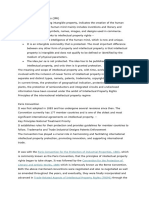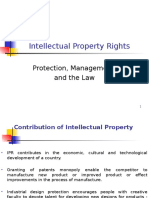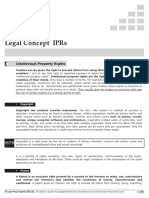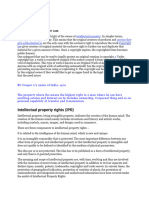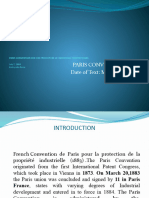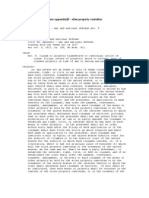Ipr - 3
Ipr - 3
Uploaded by
madhav8085601831Copyright:
Available Formats
Ipr - 3
Ipr - 3
Uploaded by
madhav8085601831Original Title
Copyright
Available Formats
Share this document
Did you find this document useful?
Is this content inappropriate?
Copyright:
Available Formats
Ipr - 3
Ipr - 3
Uploaded by
madhav8085601831Copyright:
Available Formats
IPR QUIZ MCQs
Basic concepts and terminologies related to technology, IPR and media,
Copyright - This legal term describes the rights that creators have over
their literary and artistic works. These can encompass books, music,
paintings, sculpture and films, computer programs, databases,
advertisements, maps technical drawings, etc.
Types – 1 Literary Works, dramatic work, musical works, artistic work,
cinematograph films sound recording
In case of original literary, dramatic, musical, and artistic works the time period of
copyright in India is 60 years in addition to the author's lifespan. Where there
are multiple authors, the term is 60 years post the death of the last author.
JUDGMENT - Sajeev Pillai v.In its decision, the court referred to
Section 57(1) of the Copyright Act, which gives the author the right
to restrain third parties from modifying, distorting, or making any
changes to their work.
Patents- An exclusive right granted for an invention, a patent provides the
patent owner with the right to decide how – or whether – the invention
can be used by others. In return, the patent owner makes technical
information about the invention publicly available in the published patent
document.
There are three types of patents: utility patents, design patents, and plant
patents. Each type has its own eligibility requirements and protects a
specific type of invention, useful process, or discovery. However, it's
possible for one invention or discovery to have more than one type of
patent available for it.
How long does patent protection last? Patent protection is granted for a limited period,
generally 20 years from the filing date of the application. Is a patent valid in every
country?
Landmark Judgment - Bayer Corporation vs Union of India (2014)
Bombay HC6
Indian patent office exercised its rights and granted a compulsory
license of Nexavar to Natco Pharma. Ltd
Trademarks - This is a sign capable of distinguishing the goods or services
of one enterprise from those of other enterprises.
Validity of Registered Trade MarkIf the trademark is registered,
the applicant can use the R symbol. All registered trade marks
are valid for a period of 10 years from the date of application
Certification mark
Collective trade mark
Sound trademark
Pattern mark
Trade dress
Word mark
Generic trademark
Hologram mark
What are the three elements of passing off?
The three fundamental elements of passing off are Reputation, Misrepresentation and
Damage to goodwill. These three elements are also known as the CLASSICAL
TRINITY, as restated by the House of Lords in the case of Reckitt & Colman Ltd V
Borden Inc .
Reverse passing off occurs when one party removes or obliterates the
original trademark on a product, without permission, and sells the
product either unbranded, or with the actor's own mark.
Judgement - COCA COLA VS BISLERIIt was held that the rights
over the trademark were completely assigned to Coca Cola
and Bisleri cannot use the trademark in or outside India.12
Industrial designs - An industrial design may consist of three-dimensional
features, such as the shape or surface of an article, or of two-dimensional
features, such as patterns, lines or color. It constitutes the ornamental or
aesthetic aspect of an article.
A registered industrial design is valid for the period of 15 years
from the registration date, and with its first renewal in 10 years
and subsequent renewal in every 5th year.14-Jun-2019
What are the 4 types of industrial design?
Behold the Design Garage—a categorizing of designed-object activity into four
primary fields: Commercial Design, Responsible Design, Experimental Design,
and Discursive Design
v. Gopal Gas Works, the Court emphasized the object of the
Design Act which is to protect and reward the inventor of the
design for his hard work. The Court further held that the
protection is given to advance the industries.
Geographical indications - These are signs used on goods that have a
specific geographical origin and possess qualities, a reputation or
characteristics that are essentially attributable to that place of origin.
Geographical indications registered as collective and certification marks are
generally protected for renewable ten-year periods.
Judgment - v. Gopal Gas Works, the Court emphasized the
object of the Design Act which is to protect and reward the
inventor of the design for his hard work. The Court further held
that the protection is given to advance the industries.
Trade secrets - These IP rights pertain to confidential information, which
may be sold or licensed. The unauthorized acquisition, use or disclosure
of such secret information in a manner contrary to honest commercial
practices by others is treated as an unfair practice and a violation of the
trade secret protection
trade secret protection is not limited in time (patents last in general for
up to 20 years). It may continue indefinitely as long as the secret
is not revealed to the public; trade secrets involve no registration
costs (though keeping the information confidential may entail high
costs in certain cases);
No 1773 of 2008. In Burlington Home Shopping v Rajnish Chibber;
1995 PTC (15) 278, the Delhi High Court held that a trade secret is
information that would cause real or significant harm to the owner if
disclosed to a competitor. This was also upheld in Linde v Kerr (1991)
1 All E.R. 418.11-Apr-2023
Indian laws , international treaties and agreements governing IPR
1) Indian laws related to IPR -
Trademark Act, Copyright Act, Design Act, and Patent Act.
o TRADEMARKS ACT, 1999
o The Copyright Act 1957, The Copyright Act 1957 was the first postindependence copyright
legislation in India and the law has been amended six times since 1957.[4] The most recent
amendment was in the year 2012, through the Copyright (Amendment) Act 2012.[5]
o The Design Rules, 2001 - Designs (Amendment) Rules 2008 and Designs (Amendment) Rules
2014. The last amendment in Designs Rules came in to force from 30th December 2014, which
incorporates a new category of applicant as small entity in addition to natural person and other
than small entity.
o The Patent Act,1970 – 1972 - The Patents Act has been repeatedly amended in 1999, 2002, 2005,
2006 respectively. These amendments were required to make the Patents Act TRIPS compliant.
TRIPS stands for Trade-Related Aspects of Intellectual Property Rights.
2) International treaties and agreements governing IPR - Article 27 of the
Universal Declaration of Human Rights, o Paris Convention for Industrial
Property, 1883 - It was among the first treaties to recognize various
principles of international trade like National Treatment, Right of Priority,
Common rules etc.
o Bern convention for literary and artistic works, 1886 - It provided for a
copyright system. It doesn’t provide for any formality to claim protection.
Protection is automatically accorded to any creation, provided work is
original and other conditions under the treaty are fulfilled. It means that your
work, if original, is already protected. You can claim that you have copyright.
o Madrid Agreement, 1881 – Governs the international recognition of
trademarks. Made international fillings easy and cheap.
o Patent cooperation treaty, 1970- It was earlier not possible for an entity to
claim protection in different countries by single application. This was made
possible as it aimed for co-operation, and it was open for all parties to the
Paris convention.
o Budapest Treaty of 1980 – It made possible patenting for microorganisms.
Claimant is required to deposit his invention on micro-organisms with an
Authority – ‘International depository of Micro-Organisms’ under WIPO. He
shall make all the adequate disclosures.
o Trademark Law Treaty, 1994 – Harmonized administrative procedures and
introduced ‘service marks’ in ambit of trademarks. Earlier trademarks were
accorded only to goods.
o The Hague agreement concerning the International Deposit of ‘Industrial
Design’ 1925 – It created the International Design Bureau of WIPO.
o International Union for protection of new varieties of plants, 1961 – This
provides breeders and farmers the right to new plant varieties.
o Agreement on Trade Related Aspects of Intellectual Property – It is a
landmark and most comprehensive treaty on Intellectual property. While
earlier treaties’ subject matters were specific, TRIPS deal with 8 kinds of
property rights – Patents, Trademarks, trade dress, Copyrights, Industrial
Designs, Plant Varieties, Integrated Circuits and layouts, and Geographical
Indication. Further, almost all countries are party to TRIP. In earlier treaties
only limited countries participated. It also provides an enforcement
mechanism which was not available in WIPO treaties. It mandated all
member countries to make their domestic laws compliant to TRIPS. India
passed certain laws and amended others. India’s IPR regime now stands fully
compliant to TRIPS. For E.g., India amended patent law in 2005 to provide
‘product’ patent protection. Earlier protection was available only to
‘processes.
o World Trade Organization (WTO) agreement on Trade-Related Aspects of
Intellectual Property Rights (TRIPS Agreement) - Adopted on April 15, 1994
at Marrakesh and entered into force on January 1, 1995. The TRIPS
agreement covers various types of intellectual property and provides
guidelines for minimum standards for protection, procedures and remedies
for enforcement of IPR rights and for issues related to dispute settlement.
India became a member on January 1, 1995.
o Convention Establishing the World Intellectual Property Organization
(WIPO) - Adopted on July 14, 1967 at Stockholm and entered into force on
April 26, 1970. WIPO was established under this Convention with two main
objectives - to promote the protection of intellectual property worldwide and
to ensure administrative cooperation among the intellectual property Unions
established by the treaties that WIPO administers. India became a member
on May 1, 1975.
Government and International Bodies Responsible for regulating IP law.
1) In India - The Department for Industrial Property and Promotion o Patents - The
Office of the Controller General of Patents, Designs and Trade Marks
(CGPDTM) generally known as the Indian Patent Office, is an agency under the
Department for Promotion of Industry and Internal Trade which administers the
Indian law of Patents, Designs and Trade Mark.
o the Controller General of Patents, Designs and Trademarks, (Office of the
Registrar of Trademarks), Ministry of Industry and Commerce,
Government of India
2) International bodies – WIPO 1967, came into force in 1979.
Recent Developments in the Field of AI
global AI market is presently worth $136.6 billion and will increase to $1.81
trillion by 2030.
37% of businesses have adopted AI in some capacity, according to Gartner.
Over the last four years, the proportion of businesses using AI increased by
270%.
Servion Global Solutions predicts that by 2025, AI will be used in 95% of
consumer interactions.
empowered robots to achieve human-level performance in tasks like object
detection and emotion recognition.
1. GPT-3
2. Computer Vision
3. AI in Healthcare
4. Reinforcement Learning
5. Explainable AI
6. Transfer Learning
7. AI-assisted creativity
8. Virtual agent
9. Biometrics
10. AI-optimized hardware
content generation across various domains such as art, music, literature, and
even scientific research.
AI algorithms can analyze large datasets, identify patterns, and generate
novel ideas, designs, or inventions, leading to the creation of new IP assets.
However, it raises questions about the ownership and attribution of AI-generated works
and the determination of inventorship for AI-assisted inventions.
3) What is the term of copyright for an author of the book?
Life of the author and 60 years – as per section 22 of The Copyrights
Act,1957
4) TRIPS 1986-1994 Uruguay rounds of GATT
You might also like
- Auditing Fundamentals in A South African Context Graded QuestionDocument298 pagesAuditing Fundamentals in A South African Context Graded QuestionMika-eel100% (3)
- Class Notes On Intellectual PropertyDocument19 pagesClass Notes On Intellectual PropertyRishi Sachdeva100% (1)
- Fundamentals of Jet Propulsion With Applications by Ronald D. Flack (ch-7)Document32 pagesFundamentals of Jet Propulsion With Applications by Ronald D. Flack (ch-7)Anil Kumar RoutNo ratings yet
- Cat 1Document14 pagesCat 1dhineshgunaseelan.extraNo ratings yet
- Intellectual Property Rights in India-40686877 220502 185122Document6 pagesIntellectual Property Rights in India-40686877 220502 185122Abhishek RathoreNo ratings yet
- Intellectual Property RightsDocument3 pagesIntellectual Property RightsShilpa RamdurgNo ratings yet
- Intellectual Property RightsDocument11 pagesIntellectual Property Rightsbhagatsahil608No ratings yet
- An Overview On Intellectual Property Copy Right, Patent, TradeMark EtcDocument5 pagesAn Overview On Intellectual Property Copy Right, Patent, TradeMark EtcConsultLaneNo ratings yet
- Intellectual Property RightsDocument155 pagesIntellectual Property RightsVaibhav Kumar GargNo ratings yet
- Ipr Assingment 1Document11 pagesIpr Assingment 1Dipanjal DasNo ratings yet
- Intellectual Property Rights: Protection, Management and The LawDocument26 pagesIntellectual Property Rights: Protection, Management and The LawMohsinNo ratings yet
- IPRDocument20 pagesIPREhsan IlyasNo ratings yet
- ICT Oriented Strategic Extension For Responsible Fisheries Management Manual-169-177Document9 pagesICT Oriented Strategic Extension For Responsible Fisheries Management Manual-169-177Lea LandichoNo ratings yet
- Glossary of Terms Used in IPR Session: PGP 10 Ib Sessions at SpjimrDocument2 pagesGlossary of Terms Used in IPR Session: PGP 10 Ib Sessions at SpjimrShounak MitraNo ratings yet
- Module 7Document3 pagesModule 7PALLAYYA CHOWDARY NEKKANTINo ratings yet
- IPR 2 Marks With Answers Unit 1Document3 pagesIPR 2 Marks With Answers Unit 1Madhavan SamNo ratings yet
- IPR - Its Variants & Important Judgements - 13.07.19Document32 pagesIPR - Its Variants & Important Judgements - 13.07.19Akshay ChudasamaNo ratings yet
- Intellectual Property Rights PPT Ks Doc 1Document21 pagesIntellectual Property Rights PPT Ks Doc 1Umasankar Chilumuri100% (1)
- 1IPRDocument49 pages1IPRyolevax463No ratings yet
- IPR - QuizDocument3 pagesIPR - Quizmadhav8085601831No ratings yet
- Intellectual Property Rights: S.Venugopalan NairDocument17 pagesIntellectual Property Rights: S.Venugopalan NairSANDEEP PATELNo ratings yet
- (Lecture 1 & 2) Historical Perspectives of IPRDocument4 pages(Lecture 1 & 2) Historical Perspectives of IPRSingh Bhujangi100% (4)
- Legal Concept Iprs: Intellectual Property RightsDocument5 pagesLegal Concept Iprs: Intellectual Property RightsAshutoshNo ratings yet
- Treaties For Intellectual Property Rights (IPR) ProtectionDocument35 pagesTreaties For Intellectual Property Rights (IPR) ProtectionIshikaa SethNo ratings yet
- Chapter 15 Business Intellectual PropertyDocument6 pagesChapter 15 Business Intellectual PropertyFabiola SanchezNo ratings yet
- Week 3: Mercantile Law: Final Bar Review NotesDocument60 pagesWeek 3: Mercantile Law: Final Bar Review NotesJotham Delfin FunclaraNo ratings yet
- Introduction To IPR PDFDocument40 pagesIntroduction To IPR PDFAasha100% (1)
- Intellectual Property Rights (IPR)Document37 pagesIntellectual Property Rights (IPR)anayadas.ipu095728No ratings yet
- Intellectual Property Rights - Indian ScenarioDocument6 pagesIntellectual Property Rights - Indian ScenarioDayanandhi ElangovanNo ratings yet
- Intellectual Property RightsDocument44 pagesIntellectual Property Rightskrish bhanderiNo ratings yet
- Student Notes 05 - IPR - MSC - BioAnal FYIC Boitech Nutra - 2021-22Document6 pagesStudent Notes 05 - IPR - MSC - BioAnal FYIC Boitech Nutra - 2021-22akcabhay9No ratings yet
- Ipr 2018 S.kumarDocument19 pagesIpr 2018 S.kumarMohitNo ratings yet
- Historical Perspectives of Intellectual Property RightsDocument22 pagesHistorical Perspectives of Intellectual Property RightsShraddha Bhatt ChavanNo ratings yet
- Intellectual Property Right: Met Institute of Computer Science PGDM - A (2019-2021)Document37 pagesIntellectual Property Right: Met Institute of Computer Science PGDM - A (2019-2021)StellaNo ratings yet
- How To Patent An IdeaDocument5 pagesHow To Patent An IdeaMehnaz Tabassum ShantaNo ratings yet
- Intellectual Property RightsDocument7 pagesIntellectual Property RightsVidhu JainNo ratings yet
- Intellectual Property RightDocument6 pagesIntellectual Property RightmanmahohanNo ratings yet
- Unit I: Patents and Trade SecretsDocument33 pagesUnit I: Patents and Trade SecretsdevashishNo ratings yet
- CH_7_IPDocument48 pagesCH_7_IP2022879878No ratings yet
- Intellectual PropertyDocument23 pagesIntellectual PropertyWillyanto LeeNo ratings yet
- 3202 - Intellectual Property LawDocument14 pages3202 - Intellectual Property LawMuhammed Zahangir HossainNo ratings yet
- Design ActDocument6 pagesDesign ActDaniyal SirajNo ratings yet
- LegalDocument14 pagesLegalakpandey8272No ratings yet
- CLIP Unit-4Document12 pagesCLIP Unit-4AMAN VERMANo ratings yet
- Patent U1Document5 pagesPatent U1Rajib Lochan BairiganjanNo ratings yet
- Intrinsic Factors: The Factors Relating To The Essential Nature of A Thing InherentDocument5 pagesIntrinsic Factors: The Factors Relating To The Essential Nature of A Thing Inherentvivek ghatbandheNo ratings yet
- TMGT 7500 Term PaperDocument11 pagesTMGT 7500 Term PaperwehmarNo ratings yet
- Overview of Trade Related Aspects of Intellectual Property Rights (TRIPS) AgreementDocument21 pagesOverview of Trade Related Aspects of Intellectual Property Rights (TRIPS) AgreementKinjal ShahNo ratings yet
- IPR-Intellectual Property Rights: Trade MarksDocument5 pagesIPR-Intellectual Property Rights: Trade MarksSaroj RathNo ratings yet
- SummaryDocument12 pagesSummarysanjith2k.2No ratings yet
- Unit 1Document35 pagesUnit 1ananya.2022pNo ratings yet
- Intellectual PropertyDocument7 pagesIntellectual Propertyjuhi jainNo ratings yet
- Paris - Convention ...Document16 pagesParis - Convention ...sarrnika1103No ratings yet
- Share PatentDocument18 pagesShare Patent049 Nishigandha NadavadeNo ratings yet
- TOPIC 8 - Intellectual Propperty LawDocument8 pagesTOPIC 8 - Intellectual Propperty Lawusoroa1409No ratings yet
- Paper IPR Protection in IndonesiaDocument10 pagesPaper IPR Protection in IndonesiavafranciNo ratings yet
- Intellectual Property Rights Session 2Document73 pagesIntellectual Property Rights Session 2Anuj SachdevNo ratings yet
- Legal 500 Peru - Intellectual Property (3rd Edition)Document26 pagesLegal 500 Peru - Intellectual Property (3rd Edition)Yesabel Valeria Cavero CasósNo ratings yet
- Intellectual Property in Consumer Electronics, Software and Technology StartupsFrom EverandIntellectual Property in Consumer Electronics, Software and Technology StartupsNo ratings yet
- Copyright, Patents, Trademarks and Trade Secret LawsFrom EverandCopyright, Patents, Trademarks and Trade Secret LawsNo ratings yet
- The Pocket Legal Companion to Trademark: A User-Friendly Handbook on Avoiding Lawsuits and Protecting Your TrademarksFrom EverandThe Pocket Legal Companion to Trademark: A User-Friendly Handbook on Avoiding Lawsuits and Protecting Your TrademarksNo ratings yet
- BrochureDocument23 pagesBrochuremadhav8085601831No ratings yet
- IPR - QuizDocument3 pagesIPR - Quizmadhav8085601831No ratings yet
- Novice - TORT LAW CASE JURISDICTION AND ISSUE 2Document5 pagesNovice - TORT LAW CASE JURISDICTION AND ISSUE 2madhav8085601831No ratings yet
- Compromis - SICTA, 2024Document36 pagesCompromis - SICTA, 2024madhav8085601831No ratings yet
- Black Hack - Ghost Hackers PDFDocument13 pagesBlack Hack - Ghost Hackers PDFsothNo ratings yet
- Instant Download Inside The Mind of Xi Jinping Updated Engl Ed 2018 François Bougon PDF All ChaptersDocument50 pagesInstant Download Inside The Mind of Xi Jinping Updated Engl Ed 2018 François Bougon PDF All Chaptershalepxablau100% (2)
- HR-PLWL-0001 - n28 - C2 - Pre Drive Analysis ReportDocument16 pagesHR-PLWL-0001 - n28 - C2 - Pre Drive Analysis ReportAditya narayan shuklaNo ratings yet
- Aspen Workbook - 2013Document83 pagesAspen Workbook - 2013tophat36No ratings yet
- PDF Critical Thinking Reading and Writing A Brief Guide To Argument 9Th Edition Barnet Ebook Full ChapterDocument43 pagesPDF Critical Thinking Reading and Writing A Brief Guide To Argument 9Th Edition Barnet Ebook Full Chaptercarrie.singletary159100% (5)
- Assignment of Contributor RightsDocument2 pagesAssignment of Contributor RightsMd nahidulNo ratings yet
- DOSH SSI Guidelines 1672722969Document55 pagesDOSH SSI Guidelines 1672722969Shahrulnizam Shah Mohd PadzilNo ratings yet
- Tutorial of CF DesignDocument654 pagesTutorial of CF DesignAbi Zain100% (1)
- Ethical and Social Issues in The Digital Firm: Multiple-Choice QuestionsDocument8 pagesEthical and Social Issues in The Digital Firm: Multiple-Choice Questionsliza731No ratings yet
- When Will Vijay Shekhar Sharma Be Classified As A PromoterDocument5 pagesWhen Will Vijay Shekhar Sharma Be Classified As A Promoternaishal.pNo ratings yet
- Curtius Georg. - A Grammar of The Greek Language PDFDocument415 pagesCurtius Georg. - A Grammar of The Greek Language PDFCydLosekannNo ratings yet
- Scarred Lands Master of The ScaledDocument6 pagesScarred Lands Master of The ScaledJessy DebarbieuxNo ratings yet
- IJCRT CopyrightTransferFormDocument1 pageIJCRT CopyrightTransferFormR RgkNo ratings yet
- Template - Grade 11 Entrep m5Document12 pagesTemplate - Grade 11 Entrep m5Aira Lyn Mendoza100% (1)
- 5 A Rsocially Conscious MGMTDocument37 pages5 A Rsocially Conscious MGMTEndriyani RahayuNo ratings yet
- Paul and PhiloDocument18 pagesPaul and PhiloRh2223dbNo ratings yet
- Asme Section I Int Vol 57Document25 pagesAsme Section I Int Vol 57dalvarezNo ratings yet
- Creative Industry JournalDocument24 pagesCreative Industry Journalagnihoon100% (1)
- Grade-12-MIL Q1 Week7Document20 pagesGrade-12-MIL Q1 Week7Buko PieNo ratings yet
- Full Download Traco de Giz 1St Edition Miguelanxo Prado Online Full Chapter PDFDocument69 pagesFull Download Traco de Giz 1St Edition Miguelanxo Prado Online Full Chapter PDFdaniceelanas100% (9)
- GRWFWDocument2 pagesGRWFWPierre MardiniNo ratings yet
- FusionSolar App and SUN2000 App User ManualDocument268 pagesFusionSolar App and SUN2000 App User ManualElmir GalijaševićNo ratings yet
- 50USC-Appendix 9 - Alien Property CustodianDocument12 pages50USC-Appendix 9 - Alien Property Custodianapi-3753531No ratings yet
- Capitol Records V Defries ComplaintDocument47 pagesCapitol Records V Defries Complainttitle17100% (1)
- Tajima DG/ML by Pulse Ambassador Edition Xi Version 11.0 Release NotesDocument7 pagesTajima DG/ML by Pulse Ambassador Edition Xi Version 11.0 Release NotesEverton FerreiraNo ratings yet
- PPIT Assignment SessionalDocument8 pagesPPIT Assignment SessionalJack DevilNo ratings yet
- 6&7. Composite Screens in T24Document35 pages6&7. Composite Screens in T24Muhanad JalilNo ratings yet
- Intellectual Property and The InternetDocument5 pagesIntellectual Property and The InternetTriviaNo ratings yet





